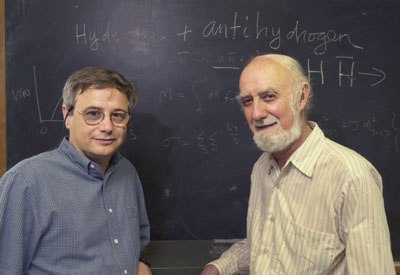Scientists explore antimatter
Scientists explore antimatter

It’s the rarest, shortest-lived matter in the universe. In fact, it’s antimatter – the opposite of matter. When the two meet, they annihilate each other in a burst of energy.
Just before the annihilation, physicists believe, strange antimatter molecules can come into existence for a trillionth of a second, or less.
At the beginning of the universe, some 15 billion years ago, cosmologists say that matter and antimatter existed in approximately equal amounts. Before there was time or space, the two just about annihilated each other. What made our universe was a slight asymmetry, a bit more matter than antimatter. That’s the matter that matters today.
“There is some question of whether, in the far reaches of the universe, some antimatter still lingers,” says Alexander Dalgarno, Phillips Professor of Astronomy at Harvard University. “People even talk about other universes. Places, perhaps, where intelligent life calls antimatter ‘matter.’ But there’s no evidence of this.”
If researchers could make enough antimatter, they could test their theories about the fundamentals of the universe, all the things they carefully theorize about its origin and reality, but really don’t know for sure.
A few dozen atoms of antihydrogen have been made so far. Back in 1995, experimenters made nine or 10 atoms of antihydrogen at the Center for European Nuclear Research (CERN) in Geneva, Switzerland. But the antimatter moved along at close to the speed of light, about 186,000 miles per second, too fast for a good look.
A team led by Gerald Gabrielse, professor of physics at Harvard, now works on a method to create a plethora of antihydrogen atoms. These atoms would be trapped in a special apparatus where they can be held long enough to accurately measure their properties. Physicists will have to work fast, however. They will have millionths of seconds to work before the antiatoms annihilate themselves by hitting the walls of the vacuum chambers made of ordinary matter.
Asked how close his team is to the goal of making a load of anithydrogen, Gabrielse replies, “Nine Harvard post-doctoral fellows and graduate students, plus collaborators from other universities, are breathing down its neck. I’m flying back and forth (to CERN) every week. I won’t stick my neck out far enough to give a date, but I’d be delighted if we made it before the end of this year.”
The millionths of a second should be long enough for the first good comparison between atoms of matter and antimatter. According to most accepted theories of the universe both have identical mass and amount of charge, but the charges are reversed. When a particle of matter has a positive charge, its antimatter equivalent will be negative and vice versa.
“All of our theories about reality are based on these assumptions,” Gabrielse notes. “In earlier experiments, we showed that protons (which form the nuclei of hydrogen atoms) and antiprotons differ by less than 90 parts in a trillion. With the current setup, we should be able to probe for even smaller differences.”
If differences are found; if, say, matter turns out to be slightly heavier or lighter than antimatter, most ideas that scientists have about the nature of physical reality will be wrong. All textbooks will have to be rewritten.
What does it matter
Gabrielse’s team would look at hydrogen and antihydrogen separately, then compare the two – to see if they both fall at the same rate in gravity, for example. Dalgarno and Bernard Zygelman, a physicist at the University of Nevada, Las Vegas, want to go one step further; they want to mix matter and antimatter.
Before the opposites annihilate each other, in much less than millionths of a second, the two hydrogens may form the very first molecule of antimatter, a molecule of antihydrogen. A regular hydrogen molecule consists of two atoms bound together; the exotic anti-molecule will be made of one hydogen atom and one antihydrogen atom. The latter would be the strangest bit of matter ever created by humans.
But it won’t last long, a trillionth of a second at most. The problem then is to measure something that takes place in such an unbelievably short time. Zygelman has come up with a way that may be a sure bet.
“As hydrogen and antihydrogen atoms approach each other, they will emit a unique footprint of radiation,” Zygelman explains. When they form a molecule, more radiation will occur. Then, in less than a trillionth of a second, the antihydrogen will be annihilated and a second burst of telltale radiation should be detectable.
“Such a radiation signature, if detected, would assure us that the antihydrogen-hydrogen molecules formed, instead of some other processes that also can occur,” Zygelman says.
“It’s a good diagnostic test,” adds Dalgarno. “It tells us that antihydrogen was present and that it joined hydrogen to make a quasi-molecule.”
If the molecule forms and antihydrogen turns out to be the same as hydrogen except for the direction of its electric charge, people can be sure the universe is pretty much like scientists think it is. If things don’t go as smoothly, the impact on physical knowledge will be tremendous. It will be one of the most important discoveries in the history of humankind.
Is there any practical advantage to be gained from this work? Bits of antimatter have been used for decades to make images of what is going on inside the body, what areas of the brain are most active when people think, for example. Positrons in this scanning technique, known as positron emission tomography (PET), are antielectrons.
In “Star Trek” and other science fiction sagas, energy from matter-antimatter annihilations powers starships on voyages to the furthest reaches of the universe in relatively short times.
Dalgarno smiles at the thought of NASA doing this for real. “The problem you need to solve,” he says, “is how to bottle antimatter atoms without annihilating them.”




